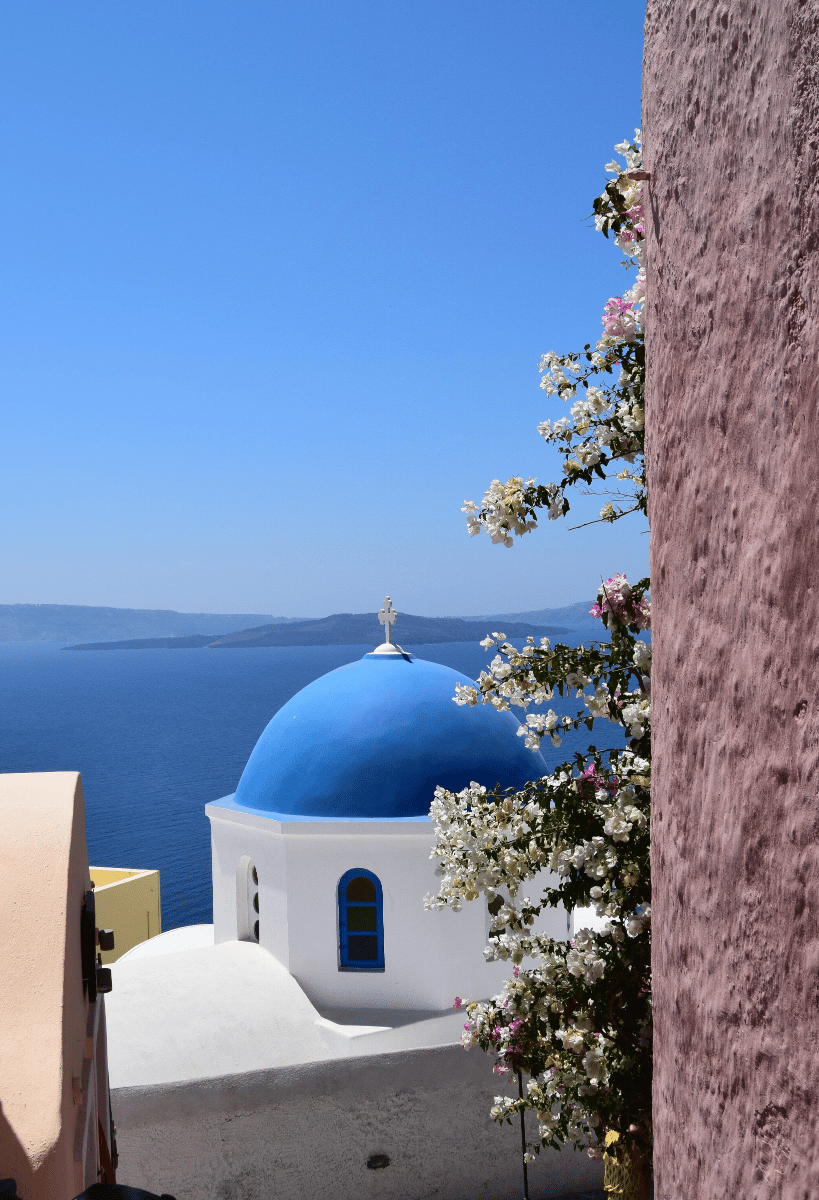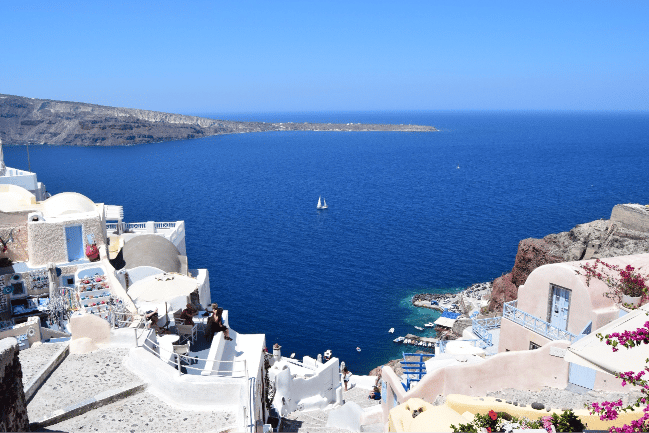Santorini
Fira
Fira is the capital and the commercial center of Santorini. Built on the caldera’s rim with beautiful views of the volcano and the sea. Here you will find all services, banks and the central post office plus the most suggestions for eating, drinking and shopping that you will find on the island. Fira has many attractions, including the Cathedral, the Archaeological Museum, the Museum of Prehistoric Thira, the Belonio Foundation, the Catholic monastery, the new museum Santozeum and Megaron Gkyzi that cover all the history of Santorini. Visit Kontochori and the Folklore Museum of Manolis Lignos to see up and close an authentic canava transformed into a museum narrating the folk history of Santorini.
Santorini night finds its expression in the streets of Fira. Koo Club, Enigma and Tango are the big clubs of the island, while guest djs come often in Casablanca. For drinking and loud music also visit Kira Thira (jazz rhythms), 2Brothers and Highlander.
Imerovigli
Imerovigli has views of the volcano, breathtaking sunsets and tranquility. There is a main square which leads up to the Caldera and the traditional hillside cave settlements. If you follow the way to Oia, the lower plains of Imerovigli also have wonderful sunset east coast views.
Its position at the highest, most central part of the caldera gave it visual command of the whole area. It also derived importance from its proximity to Skaros Fortress. The Church of the Panagia Malteza has a marvellous carved wooden screen with icons depicting scenes from the Old Testament. There is a path from Imerovigli caldera walkway to Skaros Rock and the Chapel of Panagia Theoskepasti.
- Imerovigli - Airport: 8 km.
- Imerovigli - Port: 10 km.
- Imerovigli - Oia: 9.5 km.
- Imerovigli - Perissa: 14 km.
- Imerovigli - Kamari: 9.5 km.
- Imerovigli – Fira: 3 km
-
Skaros Rock - one of the 5 fortified
castles of Santorini
-
Small supermarkets, pharmacy,
restaurants & taverns
Oia
Oia or Ano Meria (as locals call the village of Oia) is located 11 km north-east of Fira and is the absolute must- see during your visit to Santorini. The traditional settlement of Oia, which is the first that has been included in the program for the preservation and development of traditional settlements in Greece. It is a unique point that you can see and experience all the magic of Santorini. The architecture, the aura of the village and the caldera are gorgeous.
Akrotiri
Akrotiri is located in the southern part of the island and is 15 km away from Fira. Akrotiri is not exactly a hinterland village as it features coastal line and a large area that overlooks the caldera. The village itself, however, has been built very close to the sea and at the foot of the Goulas (the highest tower of Akrotiri’s castle city).
The oldest city of Santorini was developed here. The prehistoric town of Akrotiri, which came to light with the excavations of Spyros Marinatos continued from Christos Dumas, is one of the most important archaeological sites in the Mediterranean. In the medieval period Akrotiri was one of the Kastelia (castle cities) of the island and the Goulas was the last piece of the island passed under the Ottoman rule. Today is a quiet village with a fishing and agricultural character where in many parts the view to the caldera is staggering.
The Archaeological Site of Akrotiri with the city that was buried under the lava after the eruption of the volcano 3500 years ago came to light and today is visitable. Also, the Red Beach, the Goulas and Faros (the lighthouse) are places that should not be missed.
Perissa & Perivolos
Perissa is a seaside village on the south east coast of Santorini with several kilometers of black sand beach. Towering over the beach on the north side is the mountain of Mesa Vouno, site of Ancient Thira. Perissa connects with Perivolos, and the collective area is longest stretch of beach on the island. Both beaches are organized. Church of Timios Stavros, one of the largest churches on the island, Timios Stavros can be found in Perissa square. The original church, built during the period 1835 up till 1840, was destroyed by the 1956 earthquake and was later rebuilt. At the base of the mountain of Mesa Vouno, one can find the ruins of the Basilica of Agia Irini. The building dates to the 5th century, while evidence of a second construction period during the second half of the 6th century was discovered in 1992. The completion of the excavation of the site, whose floor reaches to a depth of two meters, will take several more years. For many years it was thought that Santorini was given its name by the Venetians in the 13th century. Nowadays there is strong evidence that the Basilica of Agia Irini gave Santorini its name.
Pyrgos
Pyrgos can found at the highest point of Santorini, with panoramic views of the whole island all the way to the village of Oia. This hillside village was declared a protected settlement in 1995. Pyrgos is a typical Fortress Settlement of the Cyclades. On the hilltop you can find ruins of Kasteli Castle, one of the five ‘kastelia’ on the island. Although there are many reports that Pyrgos was the capital of Santorini in the mid-18th century, the truth is that Pyrgos has never been the island’s capital. Traditional architecture, remains of neo-classical mansions, narrow winding paths leading up the hillside, small white houses, galleries, vineyards, churches, breathtaking sunsets … Pyrgos is truly magical.
If you make your way up from the main square towards the mansion of Zannos Melathron and up, you will discover one or two wonderful hillside cafes from which you can sip on a glass of wine and breathe in the sunsets and the panoramic views. Near to the village of Pyrgos and crowning Mount Profitis IIias is a monastery of the same name which was dedicated to the prophet Elijah. The monastery has an important museum – the Icons & Relics Collection. ‘Vanishing Santorini’ Exhibition is a look into Santorini’s past.


Megalochori
Megalochori is one of the most picturesque villages on the island. Its existence is recorded back to the 17th century. Home to historical mansions, old traditional houses, pirate hideaways and wine canavas, it has a history of merchants and wealthy land barons exporting Vinsanto wine that the island still produces. A prominent feature of the historical homes and mansions are the high walls, inner courtyards and solid wooden door entrances, built for privacy and for safety against marauding pirates.
A great effort is been made by local residents and businessmen to preserve the characteristics and beauty of this traditional settlement, and many of the original houses that had fallen into disrepair, have been restored to their former glory.
Wineries & Breweries
- Venetsanos Winery
- Estate Argyros Winery
- Domaine Sigalas Winery
- Koutsoyannopoulos Winery & Wine Museum
- Gavalas Winery
- Santowines Winery
- Boutari Winery
- Hatzidakis Winery
- Artemis Karamolegos Winery
- Vassaltis Winery
- Art Space Winery
- Canava Roussos Winery
- Gaia Winery
- Anydrous Winery HOME | Anhydrous Winery
- Santorini Brewing Company
- Volkan Brewery
- Ftelos Brewery We Brew Something New! | Ftelos Brewery Santorini
Museums Exhibitions &
Archaeological Sites
- Archaeological Site - AKROTIRI
- Ancient Thira - MESA VOUNO
- Archaeological Museum - FIRA
- Museum of Prehistoric - Thira
- Lignos Folklore Museum - FIRA
- Megaro Gyzi Museum - FIRA
- Naval Maritime Museum - OIA
- G. Emmanuel Argyros Mansion - MESSARIA
- ‘The Wall Paintings of Thera’ - FIRA
- Bellonio Cultural Center - FIRA
- Art Space Argyros Canava - EXO GONIA
- Icons & Relics Collection - PYRGOS
- Exhibition of Santorini’s past “Vanishing Santorini” - PYRGOS
- Museum of Minerals & Fossils - PERISSA
- Wine Museum - VOTHONAS
- Lost Atlantis - MEGALOCHORI